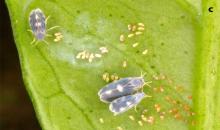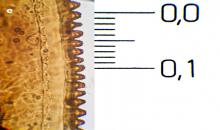
4th Meeting of the EPPO Panel on Diagnostics in Entomology
Paris, 2016-11-29/12-01
The 4th meeting of the EPPO Panel on Diagnostics in Entomology took place in the EPPO headquarters . The Panel continued its work on the preparation and revision of Diagnostic Protocols for entomology.
Discussions on pest-specific diagnostic protocols
The Panel discussed the following Diagnostic Protocols:
- Aleurocanthus spiniferus and A. woglumi
A revision of the Diagnostic Protocol could be initiated during spring 2018 in order to include the results of a research project that need to remain confidential until their publication in a peer-reviewed journal which is planned in 2017.
 |
 |
 |
| A. spiniferus - Courtesy: Francesco Porcelli, Università di Bari (IT) and MA van den Berg, ITSC, Nelspruit (ZA) | ||
- Thrips palmi
The revision of the EPPO Diagnostic Protocol was agreed to align it to the IPPC Standard ISPM 27 ‘Diagnostic protocol for T. palmi’. A survey was organized among Thrips palmi experts to identify which test(s) were currently used in the region, in order to describe these tests in full in appendices, and it appeared that only the COI sequence-based real-time PCR test (Kox et al., 2005) is used, while other tests described in the IPPC protocol are not used. A LAMP test validated by Mr Bühlmann (Agroscope, CH) could also be included in the EPPO Protocol. The EPPO Standard will be sent for country consultation.
- Diabrotica virgifera
The authors of the Diagnostic Protocol provided their responses to the comments gathered during country consultation. The scope of the Diagnostic Protocol was restricted from ‘Diabrotica virgifera’ to ‘Diabrotica virgifera virgifera’ as in Europe only Diabrotica virgifera virgifera is present; information on other beetle species that can be confused with Diabrotica virgifera virgifera is also provided. The protocol was revised to take into account Panel discussions and will be sent for the last stage of consultation for final approval.
- Helicoverpa armigera
The Panel confirmed the need for this Diagnostic Protocol to contain information to distinguish between Helicoverpa armigera and Helicoverpa zea, two species that can be confused. The keys used for species identification are based on geographical origin, but with the increasing overlapping distribution (in the American continent) of the two species, the keys cannot be used anymore. The Panel agreed that molecular tests and genome sequencing would help pest identification and that multiplex real-time PCR (Gilligan et al., 2015) should be included in the protocol. A revision will be presented at the next Panel meeting.
- Opogona sacchari
Work on the Diagnostic Protocol was delayed because the author could not obtain specimens of a similar species, O. omoscopa, needed to prepare an illustrated description. A new version could be ready for the next Panel meeting.
- Epitrix cucumeris, E. similaris, E. subcrinita, E. tuberis
The Protocol was revised and sent for country consultation. Only minor comments were received. Panel discussed the need to include RLFP-PCR to allow identification of the pests but noted that the test does not allow the distinction between E. subcrinita and E. cucumeris. A reference to the test with an explanation on its limits was added. The Protocol was revised to take into account Panel discussions and will be sent for the last stage of consultation for final approval.
- Dacus ciliatus
The Panel discussed the relevance of the inclusion in the Diagnostic Protocol of the description of larvae, as morphological identification can only be performed on adults; larvae can be used for identification to genus level and are reared to obtain adults, it was agreed to modify the Protocol to include information for larvae identification as a tephritid larvae. The EPPO Standard will be finalised and will be sent for country consultation.
- Zeugodacus cucurbitae
The Panel noted that the Protocol should highlight that there have been taxonomic changes and that previous literature referred to Bactrocera cucurbitae. The EPPO Standard will be finalised and will be sent for country consultation.
- Philaenus spumarius
The Panel on Diagnostics and Quality Assurance suggested that a Diagnostic Protocol should be developed for vectors of Xylella fastidiosa. The Panel agreed that knowledge on Cicadidae is missing and keys for identification are old and not-practical; moreover, limited information is available for other Philaenus species and these show a great variability in habitus for species from Russia to Western Europe. Links with the Euphresco project ‘Xylella fastidiosa and its insect vectors Cicadella’ could be established to gather useful information and specimens for morphological analysis.
- Thaumatotibia leucotreta
A first draft of the Diagnostic Protocol will be prepared in 2017.
- Agrilus planipennis and Agrilus anxius
Contact was made with experts from North America to identify experts willing to help with the preparation of this Diagnostic Protocol.
Future priorities for revision and future programme for specific protocols
Panel members discussed the priorities for the development of a new Diagnostic Protocol on Thrips setosus. A document for field recognition already exists, but this was intended for inspectors and not diagnosticians. It was agreed to prepare a very short diagnostic guideline based on the article of Vierbergen and Loomans, 2016 to complement the information available to inspectors.
The Panel also discussed the possible revision of the Diagnostic Protocols on:
- Diaphorina citri: it was suggested to revise the Diagnostic Protocol PM 7/52 to include closely related species that are difficult to distinguish morphologically.
- Rhynchophorus ferrugineus and Rhynchophorus palmarum: it was suggested to revise the Diagnostic Protocol PM 7/83 to include information on Rhynchophorus vulneratus to avoid misidentification (the species identified as Rhynchophorus ferrugineus in California in 2010 was actually Rhynchophorus vulneratus).
Projects with a direct link to diagnostics
Outcomes of the Q-collect project
The Panel was invited to share their thoughts on the Q-collect deliverables and in particular the ‘Draft guidelines on quality assurance for reference collections’. Discussions were held on collections, what reference collections or working collections are and practices according to different disciplines or collections. Experts were identified to review the Q-collect deliverables.
Q-bank
A project for preparing the transfer of Q-bank data and functions was agreed by the EPPO Council (September 2016). Safeguarding data was seen as a short-term need and the main goal of Panel discussion was to identify data that should be considered as priorities for inclusion over a period of 3-5 years.
- Priority dataset: the Panel agreed that for entomology specimens are unique reference material from a morphological and molecular point of view and as such they cannot be shared while DNA material could be shared. They agreed that information on specimens, the DNA and the molecular sequences had to be considered as priorities for transfer.
- Priority species: species that have sequence data (201 out of 447 arthropod species) and species for which metadata are available should be considered as priorities for transfer. The Panel suggested that the EPPO Secretariat should analyse the metadata displayed in the Q-bank database and compare it to the metadata recommended in the Q-collect guidelines.
- The Panel agreed that other priorities could be identified at the next Panel meeting.
The next meeting will be held in 2018.
